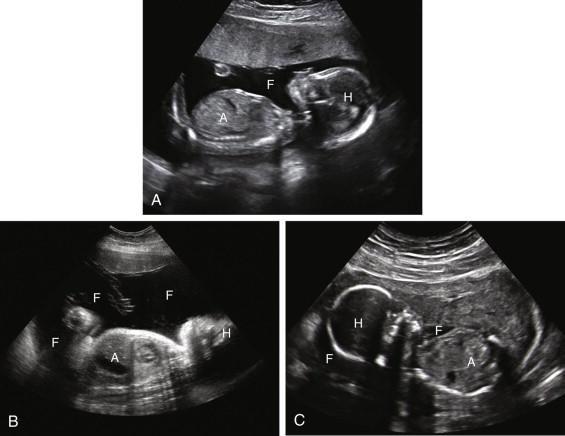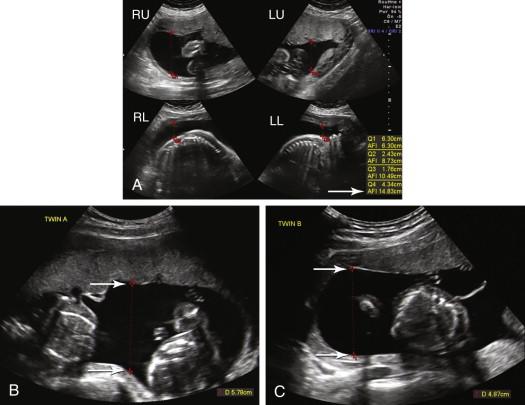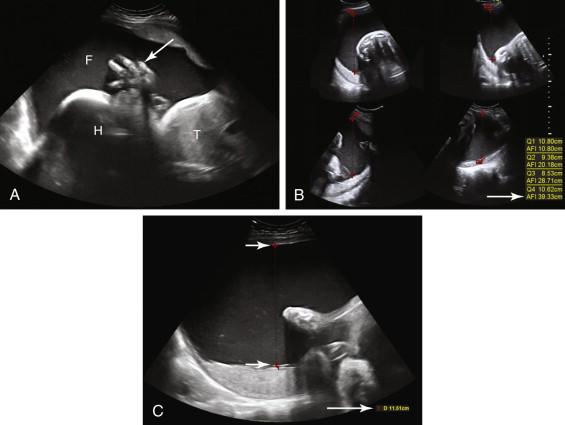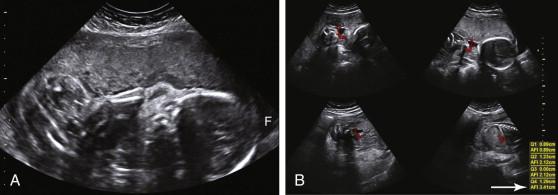Physical Address
304 North Cardinal St.
Dorchester Center, MA 02124
The sonographic evaluation of the fetus includes assessments that extend beyond simple evaluation of fetal anatomy. Fetal well-being can be evaluated using surveillance methods such as fetal size and growth, Doppler waveform analysis, and the biophysical profile (BPP). In combination with the clinical findings, these tests help predict when fetuses are compromised and facilitate management decisions such as the timing of delivery.
Amniotic fluid volume is dependent on the balance between production and removal of amniotic fluid. The major source of amniotic fluid during the second and third trimesters is production of urine by the fetal kidneys followed by fetal urination into the amniotic cavity. In addition, the fetal lungs and skin are responsible for producing a small component of amniotic fluid. The most important etiology of amniotic fluid removal is absorption by the gastrointestinal tract. Fetal swallowing is important in amniotic fluid removal because delivery of fluid into the gastrointestinal tract depends on swallowing.
Amniotic fluid volume can be analyzed both subjectively and quantitatively. In the hands of experienced examiners, subjective assessment is accurate in assessing amniotic fluid volume and usually correlates well with quantitative measures ( Fig. 13-1 ). The most widely used quantitative measurement of amniotic fluid is the amniotic fluid index (AFI). The AFI is obtained by dividing the gravid uterus into four quadrants (i.e., left upper, left lower, right upper, and right lower), measuring the deepest fluid pocket that does not contain fetal parts or umbilical cord in each quadrant, and adding the four-quadrant measurements together ( Fig. 13-2A ). The AFI is performed with the patient in the supine position, measuring with the transducer oriented perpendicular to the floor, even if a larger pocket of fluid can be imaged in an oblique scan plane. Normal values vary with gestational age; tables of gestational age–specific values have been published and a representative example is presented in Table 13-1 . Many practices use a threshold of 24 cm or larger for diagnosing polyhydramnios and less than 5 to 8 cm for diagnosing oligohydramnios. Another quantitative method of reporting amniotic fluid volume is the single deepest pocket, also termed the maximum vertical pocket (MVP), which measures the single deepest pocket that does not contain fetal parts or umbilical cord. Normal values for the MVP range from 2 to 8 cm. The MVP is particularly useful for describing amniotic fluid volume in multiple gestations because a four-quadrant AFI cannot be performed for each fetus of a multiple gestation pregnancy (see Fig. 13-2B and C ).


| Amniotic Fluid Index Percentile Values | |||
|---|---|---|---|
| Week | 5th | 50th | 95th |
| 16 | 7.9 | 12.1 | 18.5 |
| 17 | 8.3 | 12.7 | 19.4 |
| 18 | 8.7 | 13.3 | 20.2 |
| 19 | 9.0 | 13.7 | 20.7 |
| 20 | 9.3 | 14.1 | 21.2 |
| 21 | 9.5 | 14.3 | 21.4 |
| 22 | 9.7 | 14.5 | 21.6 |
| 23 | 9.8 | 14.6 | 21.8 |
| 24 | 9.8 | 14.7 | 21.9 |
| 25 | 9.7 | 14.7 | 22.1 |
| 26 | 9.7 | 14.7 | 22.3 |
| 27 | 9.5 | 14.6 | 22.6 |
| 28 | 9.4 | 14.6 | 22.8 |
| 29 | 9.2 | 14.5 | 23.1 |
| 30 | 9.0 | 14.5 | 23.4 |
| 31 | 8.8 | 14.4 | 23.8 |
| 32 | 8.6 | 14.4 | 24.2 |
| 33 | 8.3 | 14.3 | 24.5 |
| 34 | 8.1 | 14.2 | 24.8 |
| 35 | 7.9 | 14.0 | 24.9 |
| 36 | 7.7 | 13.8 | 24.9 |
| 37 | 7.5 | 13.5 | 24.4 |
| 38 | 7.3 | 13.2 | 23.9 |
| 39 | 7.2 | 12.7 | 22.6 |
| 40 | 7.1 | 12.3 | 21.4 |
| 41 | 7.0 | 11.6 | 19.4 |
| 42 | 6.9 | 11.0 | 17.5 |
Polyhydramnios refers to an abnormally large volume of amniotic fluid ( Fig. 13-3 ). There are numerous underlying causes for polyhydramnios ( Box 13-1 ). More than half of the cases are idiopathic, with no identifiable cause for the increased fluid volume. Idiopathic cases of polyhydramnios are more likely to be associated with only mildly increased fluid. The remaining cases can be divided into maternal etiologies, fetal etiologies, and multiple gestations. The most common maternal etiology is diabetes mellitus. Polyhydramnios in diabetic patients is associated with an increased likelihood of macrosomia and is more likely when the diabetes is poorly controlled. Immune hydrops is an additional maternal etiology of polyhydramnios.

Idiopathic
Maternal
Diabetes mellitus
Immune hydrops
Fetal
Structural anomalies
Gastrointestinal tract obstruction or atresia
Extrinsic compression on esophagus: cervical or thoracic mass
Fetal swallowing dysfunction: facial cleft, central nervous system, musculoskeletal disorder
Cardiac: structural anomalies, arrhythmia, high-output failure
Fetal and placental tumors
Skeletal malformations
Syndromes
Chromosomal abnormalities
In utero infection
Fetal anemia
Nonimmune hydrops
Multiple gestations
Composite fluid from multiple gestations
Twin-to-twin transfusion
Fetal etiologies of polyhydramnios include structural anomalies, chromosomal abnormalities, in utero infection, fetal anemia, and nonimmune hydrops. Severe cases of polyhydramnios are more likely to be associated with a fetal abnormality. Structural anomalies causing polyhydramnios include gastrointestinal tract obstruction or atresia as well as large cervical or thoracic masses such as fetal goiter, cervical teratoma, and congenital diaphragmatic hernia, which result in extrinsic compression on the esophagus, thus leading to failure of normal intestinal absorption. Anomalies that interfere with fetal swallowing such as facial clefts, micrognathia, central nervous system lesions, and musculoskeletal disorders also cause polyhydramnios due to decreased intestinal absorption of fluid. Additional etiologies of polyhydramnios include cardiac abnormalities such as structural heart anomalies, increased cardiac output, and cardiac arrhythmias; fetal and placental tumors; skeletal malformations; syndromes; and hydrops.
The overall amount of amniotic fluid in multiple gestations is increased because of the composite of fluid contributed by each gestation. Complications related to multiple gestations such as twin-to-twin transfusion further increase the incidence of polyhydramnios.
Oligohydramnios refers to an abnormally small volume of amniotic fluid ( Fig. 13-4 ). Anhydramnios is the most severe form of oligohydramnios and indicates absence of amniotic fluid. Etiologies of oligohydramnios are preterm rupture of membranes, fetal urinary tract anomalies, growth restriction due to uteroplacental insufficiency, post-term pregnancy, chromosomal abnormalities, and iatrogenic causes (e.g., medications and complications of procedures; Box 13-2 ). Some cases are idiopathic. Anhydramnios and severe oligohydramnios in the second trimester may lead to lethal pulmonary hypoplasia, craniofacial deformities, and limb contractures. This conglomeration of findings is termed Potter's syndrome when seen in the setting of bilateral renal agenesis. Oligohydramnios due to urinary tract abnormalities is discussed further in Chapter 18 . Lack of amniotic fluid compromises evaluation of fetal anatomy due to lack of sonographic windows for imaging and crowding of fetal structures. Potential pitfalls in diagnosing oligohydramnios include false positives due to large maternal body habitus, resulting in artifactual echoes in the amniotic fluid that are misinterpreted as layers of the uterus, or excessive pressure with the transducer displacing amniotic fluid out of the field of view.

Preterm rupture of membranes
Fetal urinary tract anomalies
Growth restriction due to uteroplacental insufficiency
Post-term pregnancy
Chromosomal abnormalities
Iatrogenic (e.g., medications and complications of procedures)
Become a Clinical Tree membership for Full access and enjoy Unlimited articles
If you are a member. Log in here